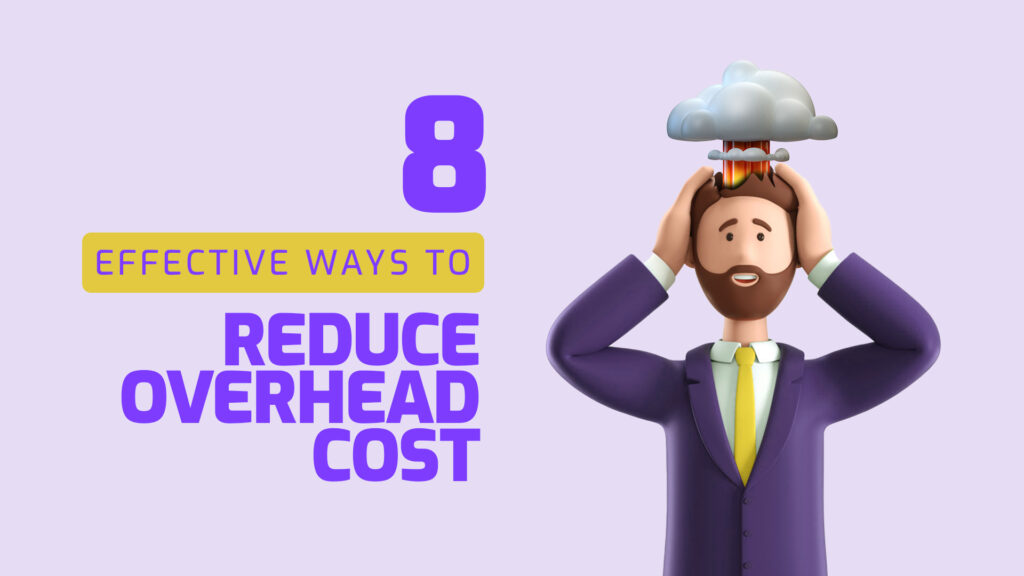Your overhead costs are parasites eating up your business little by little if not kept in check. Those forgotten subscriptions, unnecessarily high rents, inefficient employees, and internet charges leak all your revenue without you even realizing it. You certainly need to spend money to earn money, but you can avoid these pitfalls that hamper your company’s growth. There are many ways to decrease overhead expenses, increase profit margins, avoid cash flow problems, and keep your business afloat even through economic downturns like the one we’re experiencing these days. All of your business’s recurring costs that do not directly impact the production are overhead costs. Office rent, maintenance, employee payrolls, management and marketing charges come under the tag of overhead costs. It is a good practice to keep your overhead costs in check throughout the year, but economically unstable times and low revenue seasons, require more action on cutting overhead expenses to a minimum. Let’s dive deep into ways to reduce overhead costs without damaging your growth or quality. 1. Analyze A Deep Analysis of your Business’s Revenue Before you get on a layoff spree, do an in-depth analysis of your revenue model and your bottom line. Go through your profit and loss statement line by line, and examine what might be a waste of money. This would allow you to cut out funds going towards things you don’t necessarily need. Metric develops the profit-loss statements for you while giving weekly, monthly and yearly cash flow reports, which limits this lengthy procedure to merely minutes. This occasional check keeps you aware of your financial health and spending trajectory. Revisit Costs After a period of big growth and profits, be careful to revisit all costs and make decisions based on updated data. While reviewing, mark off items that you consider expensive, that can be made more efficient, or those that are simply not needed anymore. All such items can be eliminated when the company requires. Scale Down Variable Costs Desperate times call for desperate measures. During low sale periods or a global recession, you must scale down on variable costs that are acceptable and even preferred in normal business operations. Once you’ve reviewed your costs, you can cut down on some unneeded liabilities and temporarily stop a few services. This step might require a change of strategy or even a different mode of work for employees but would greatly benefit in saving the company’s revenue in hard times. 2. Automate Automate Payments Suppose you keep forgetting the bill payment due dates and always end up paying fine charges. This might seem like a small amount but when added every month costs you a great deal which could easily be avoided by timely payments. Metric helps you optimize your cash flow by paying invoices on their due date thus saving you from overdue bills. Automate Administrative Tasks Automating generic tasks like invoicing, appointments, scheduling, client follow-ups and others of the sort through apps like Metric, takes so much off your plate. Companies hire separate employees for these functions which costs you an extra expense. Mostly, founders try to do it themselves with their already hectic schedules, this burns them out and greatly increases the risks of error. 3. Invest in an Accountant You’re laying off your visiting staff, and we’re suggesting a new hire! Regardless of how ridiculous it might sound to you now, you’ll thank us later. Tough times require accountancy support like never before. Taking the right decision, saving your revenue, and keeping your company afloat, all while dealing with a recession is not something you could manage alone. With all other things, you need the support of an accountant for cutting overhead costs and helping you with the layoff if needed. Metric’s “Growing” plan offers you automated generic tasks along with professional accountant support. However, if you’re a small company and can no way invest in an accountant right now, then Metric’s free plan works best for you. It facilitates you through insights and cloud-based real-time financial dashboards that assist you in making the right move in your business. 4. Re-evaluate Office Space and Equipment Expenses Cost-Effective Office Space A larger part of your revenue goes into office space rent. A great office location undoubtedly reduces turnover rates and absenteeism, both of which can be sources of great financial loss. However, if your company is going through hard times, it’s always a good idea to reevaluate your office size and location. If your operations and productivity don’t get affected by a different location or a smaller office, it’s time to move. Rent not Buy Equipment For your operations, you might need a few pieces of equipment once a month or even less. For a small business, it’s not smart to invest in buying equipment that you would use this rarely. Reach out to suppliers renting those pieces of equipment, make a contract of monthly renting for a few days, and save your precious capital. 5. Smart Employee Management Trim Excess Staff When your business was growing and spreading, you might have hired a larger workforce than you require. Employee wages are one of the highest contributing factors to your overhead cost. Low performers are a drain on the company but layoffs certainly do impact the morale and productivity of the employees left. Thus ideally, it’s always better to make smarter hiring choices and go for multi-skilled candidates that could be used in other roles when needed. Invest to Reduce Turnover The company invests a huge amount of capital, time and effort in recruiting and training a single employee. According to this report, Voluntary employee turnover costs U.S. businesses $1 trillion per year. Even if you have other important expenses, setting an amount to maintain a healthy work environment and incentives for staff to stay is a must. IN economic downturns or company’s hard times, you can go for cheap alternatives to have the team refreshed and entertained. It is always a good choice to involve your team in the




